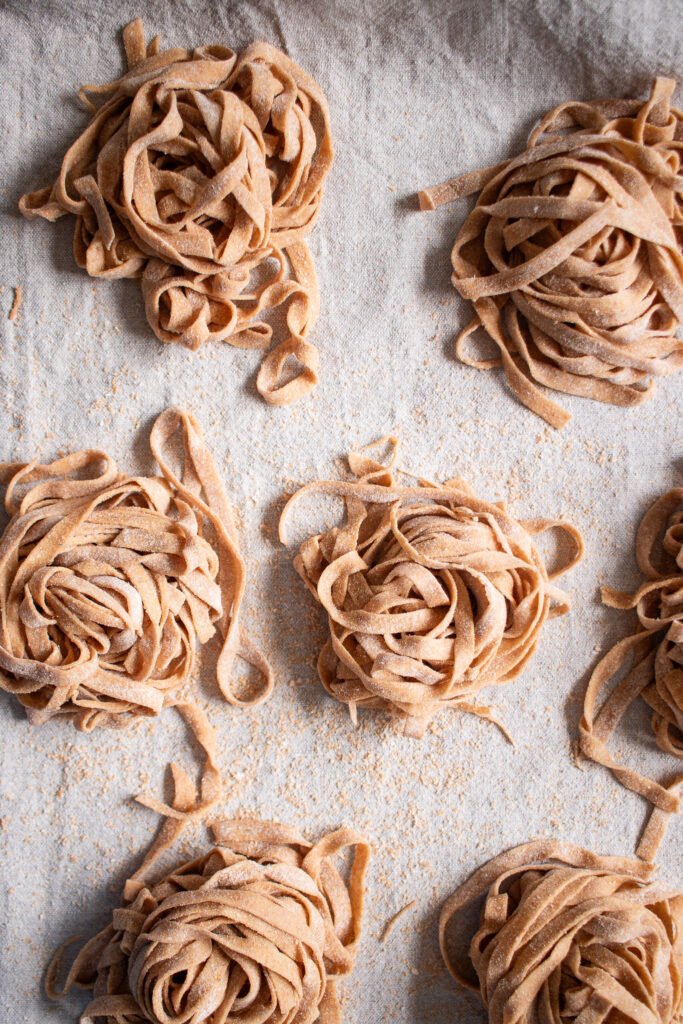
I love making pasta, it’s such a beautiful and versatile thing, you can make everything from a simple noodle dish to a lasagna and delicious pasta pillows with soft fillings as well as various folded and quick-fried delicacies out of something as simple as flour, eggs and a splash of water.
In both Italian and French, the term dough is used a little differently than we do in English. Pasta simply means dough, but it sounds a little better to say “let’s eat some pasta” than to say “let’s eat some dough”. Dough doesn’t quite have the same ring to it and yes, it would almost be a bit gross if we actually did say “let’s eat some dough”, unless if it was cookie dough, right?
In spite of that pasta simply means dough and since it is a dough, that part actually makes sense. Pasta is probably one of the simplest doughs ever made. A 2-3 ingredient unleavened dough, usually made from flour and eggs in its most nutritious form and otherwise just with water.
So there truly isn’t any reason whatsoever, to buy the crap they sell in the grocery store. When you get the hang of making pasta at home, there’s no way back. It takes a while to learn to master this simple dough. But if every old Italian mamma could learn this at a young age back in the days, so can you!
The best part of making pasta, is when you finally master the technique. It’s simply marvellous! Trust me, you will never go back to that terrible yucky bromated, enriched flour pasta you can find in the grocery store, ever again! And you will think twice before buying that bag of 7$ ancient grains pasta in Whole Foods, because you know you can do it 1000 times better yourself.
Ever since I actually moved to Italy the first time back in 2010, I have seen prefab pasta as mockery of an extremely delicate and versatile food, which is based on craftsmanship and a very beautiful slow food tradition. A tradition that always was rooted in simple ingredients of the highest quality. Slow food at its best, made from scratch at a leisurely pace and not in a hurry.
Since when did we become so important, that our insane pace of life has to ruin something as beautiful and slow as real food preparation? Most people like to hurry everything, they hurry through the day? There’s nowhere in the bible that says, we need to hurry, nobody asks you to hurry up and cook our food or hurry your life in general. So I don’t believe that, all this hurrying up is a thing I want to be a part of and I am quite sure it isn’t something that God intended for us to do?
I absolute love to make food in the slow. I do not like to be hurried or to stress it. When you hurry you kill all the good intentions and it depletes your food from all the love that could have been poured into that dish, so why cook in a hurry?
When I do spend time on silly things like Instagram which I seldom do, I tend to watch videos of old Italian nonnas (grandmas) making pasta in their own time. It is probably one of the most joyful things you can watch, old wrinkly hands working in a meditative and precise pace. In settings that doesn’t aim to be anything close to fancy but just a home, where life has been lived in a much less hurried manner.
Making pasta yourself is even more lovely, that feeling of kneading and rolling a perfect pasta dough. It’s just a giving experience to make and to eat not to forget!
This is a very simple pasta recipe it contains 2 ingredients freshly milled spelt berries and whole pastured eggs. There is no industrially abused flour nor additives in this recipe. It is a bit more messy than making it with an “aged” flour like Jovial and it might take an hour and a half to make. So don’t do it, if you are in a hurry. I believe cooking in a hurry seems to be a bad idea in general, so I try not to do it. Making pasta from a fresh milled flour is definitely worth the time, as it tastes so yummy and you will be happy that you didn’t just go and buy some plasticky, yucky fake version of pasta from the grocery store again.
This pasta just feels right, when you knead, roll, cut and eat it from a fork or spoon. You can taste those hands that kneaded it for almost half an hour and the quality of the ingredients, the simplicity, the time and the love behind it. You can taste it all!
It is all so worth it, thank you God for giving me the patience to cook good food!
So let’s get started!
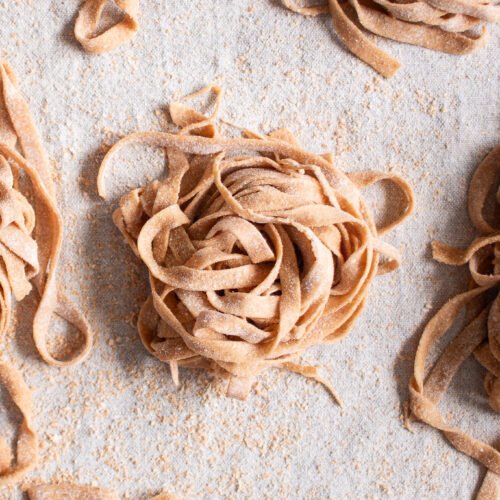
Freshly milled Spelt Pasta
Equipment
- 1 Manual Pasta Machine (or a rolling pin)
Ingredients
- 300 g Spelt berries
- 3 L Pastured Eggs
Instructions
- Mill the spelt as finely as possible, on my mill that would be on 1 for spelt.
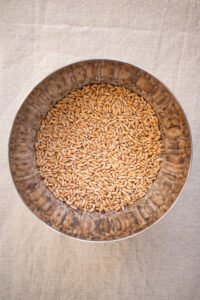
- If you do not have a stainless steel or marble countertop, it can be less messy to use a bowl. Even though I prefer using the volcano method myself, I simply don't like the mess it makes on my wooden countertop, so unless you have a proper countertop or a pasta table, you can simply make the volcano in a big mixing simply by making a well in the flour like this.

- Crack your eggs into the well.

- Whisk the eggs with a fork.

- It doesn't have to be more than this, the yolks simply need to be broken down.

- Then I use one hand to mix the flour into the egg mixture.
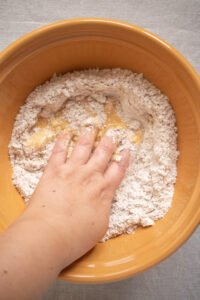
- It takes a little time to create a dough ball so be patient and keep working the dough, simply add Love and time into it.

- This is how my dough looks before I start kneading it. It is very rustic.
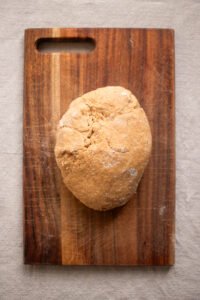
- A pasta dough needs to be pulled and folded to become smooth. This kneading process can be a bit physically demanding and it might take 10-20 minutes to get a super smooth pasta dough. Start by stretching the dough as far as you can without breaking it.
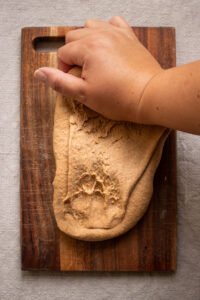
- Then fold the dough over itself and repeat until the dough starts to feel smooth and even. I usually set an egg timer for 10 minutes and if I'm not at a point where I feel the dough is nice and smooth and not sticky, I knead it another 5-10 minutes.
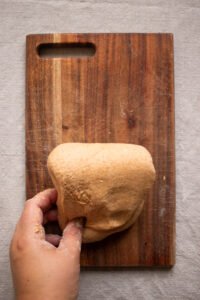
- When the dough can be formed into a smooth ball without getting dough on your fingers and it is super smooth and slightly shiny on the surface, it is ready. At this point I would usually wrap it in a piece of waxed linen or plastic wrap. Then I let the dough rest for at least 30 minutes and preferably for an hour in the refrigerator.
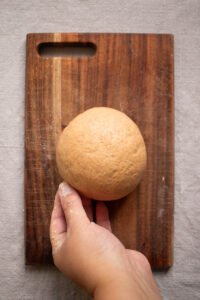
- When the dough has rested, I usually cut it into 4 parts and press the first part down with the palm of my hand and roll it until it is approx. half an inch. Then it is ready for the pasta machine. If you don't have a pasta machine, you continue working with your rolling pin exactly as if you had a pasta machine. It's the same as a rolling pin, you roll, fold and roll again. Each time you just roll out thinner and thinner.
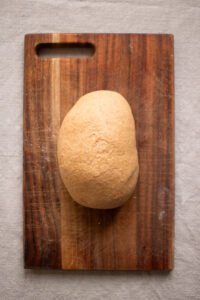
- There are several thickness settings on a pasta machine, there are about 6 settings on my old Imperia. So just start with the widest setting at first.

- Then you take and insert the dough 3 to 4 times on the first three settings. Just run the dough through and fold it 3 times and run it through the same setting again, and repeat this until the dough comes out very smooth. When you have reached the middle setting, you can run the dough on the second finest setting and when the dough looks nice and smooth, cut the edges of the dough and sprinkle it with flour and run it through the last setting if you are making lasagna sheets.
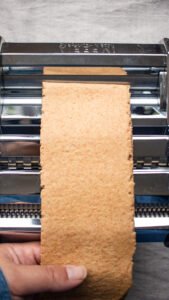
- If you want to make fettucine or linguine, the sheets don't have to be as thin as for lasagna. So, just roll the floured sheets through the fettucine/linguine pasta setting on the machine. This is also where you fold your dough in 3 and cut it with a knife if you make traditional Mamma pasta without a machine. (Remember to sprinkle with plenty of flour, otherwise you'll risk the pasta sticking together and yes, that means you have to start all over again).
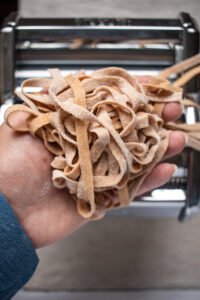
- Since I decided to make fettucine here. I decided to shape the noodles into bird's nests and stretched them on a piece of linen and dried them for an hour until I cooked them in plenty of boiling water.
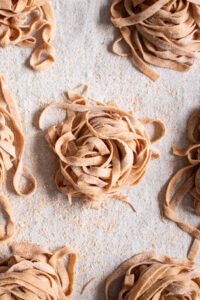
- This method makes it easier to transfer the noodles to the boiling water and the pasta is less likely to stick together during cooking. I cooked this pasta aldente, it took about 5-6 minutes in boiling water. Spelt takes longer to become aldente than wheat pasta, so add a few minutes extra cooking time.
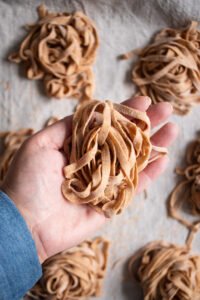
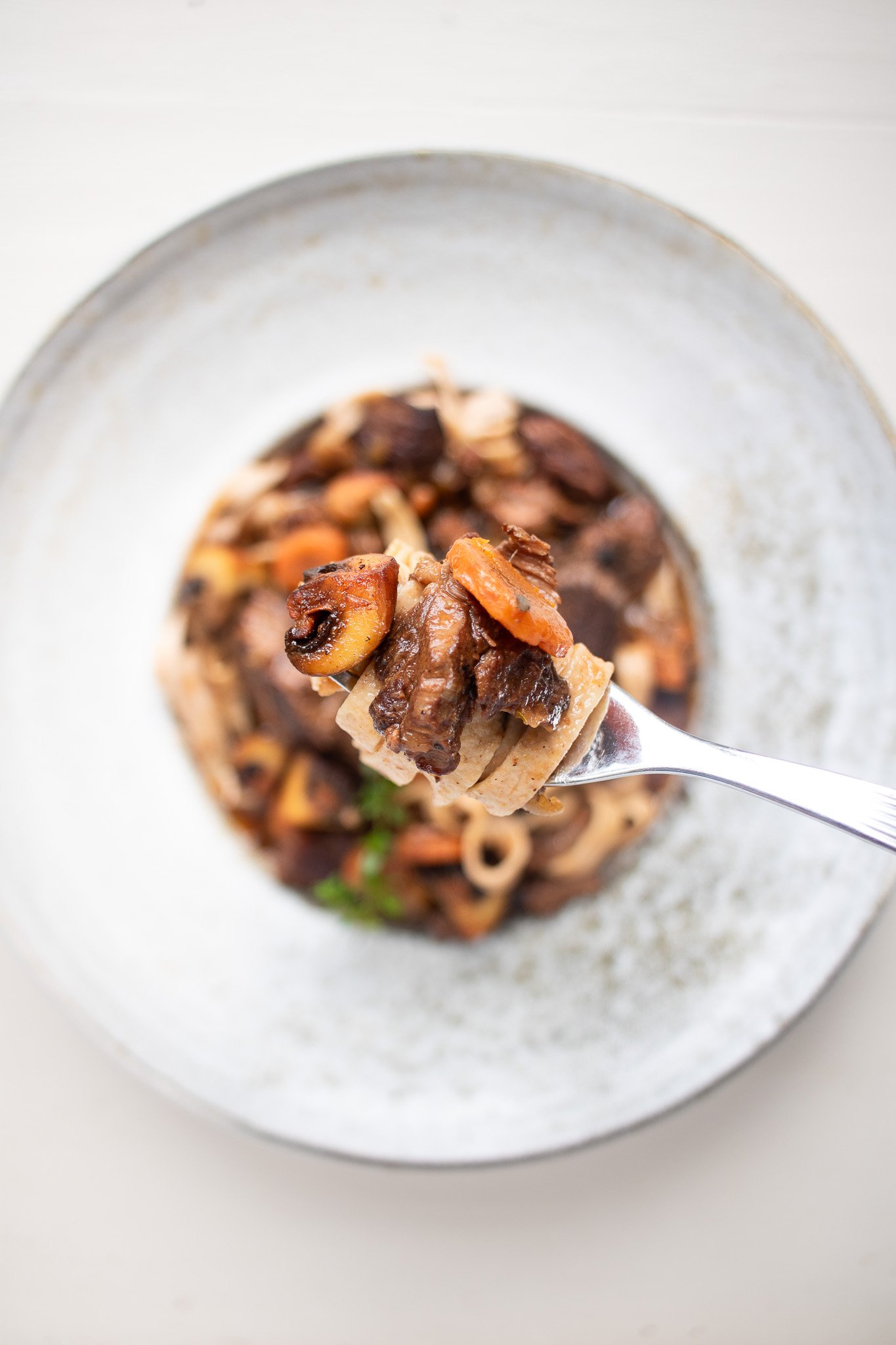
This fettucine was served with my Bœuf Bourguignon another slow food dish, that never can and never should be hurried. This combo tasted great btw! Now it’s your turn to shine. I pray you will succeed, maybe not the first time but if you keep trying, I am sure you will. Patience and a calm attitude is the way to go when it comes to pasta making and most things in life. If you are uncertain or need help, just remember that you can always ask me. Have a wonderful and blessed day dear friend.
Much Love in Christ

P.S. all posts on this blog are written and photographed by Belle Frost, no AI has been used to generate content and all Copyright belongs to The Holy Food Co.



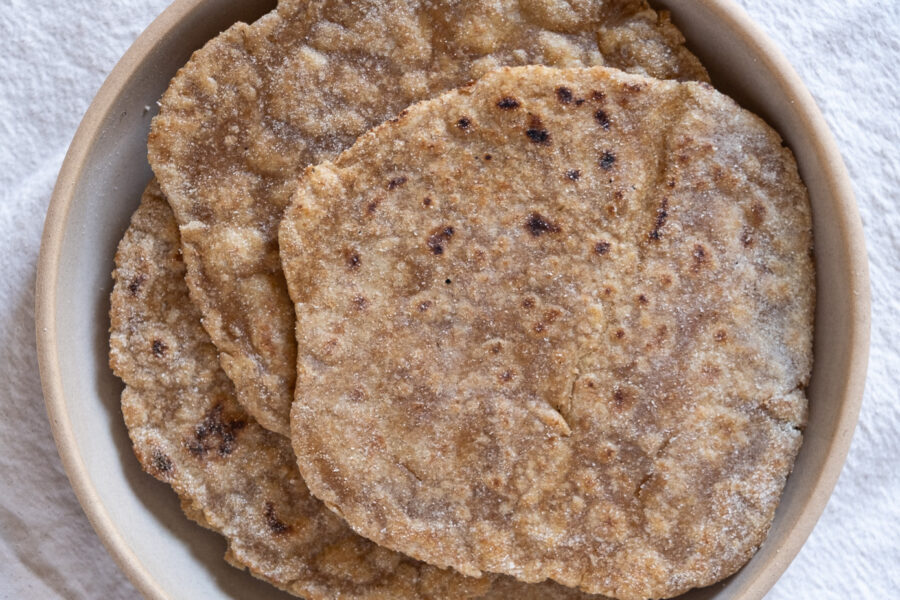




Leave a Reply